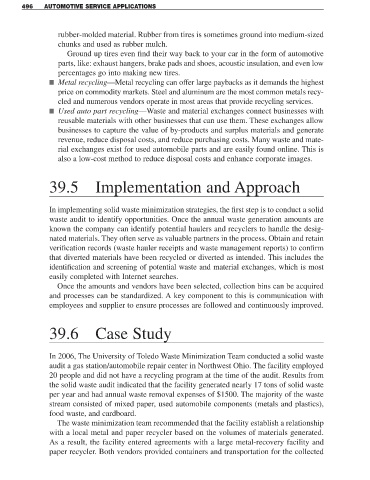Page 518 - Solid Waste Analysis and Minimization a Systems Approach
P. 518
496 AUTOMOTIVE SERVICE APPLICATIONS
rubber-molded material. Rubber from tires is sometimes ground into medium-sized
chunks and used as rubber mulch.
Ground up tires even find their way back to your car in the form of automotive
parts, like: exhaust hangers, brake pads and shoes, acoustic insulation, and even low
percentages go into making new tires.
■ Metal recycling—Metal recycling can offer large paybacks as it demands the highest
price on commodity markets. Steel and aluminum are the most common metals recy-
cled and numerous vendors operate in most areas that provide recycling services.
■ Used auto part recycling—Waste and material exchanges connect businesses with
reusable materials with other businesses that can use them. These exchanges allow
businesses to capture the value of by-products and surplus materials and generate
revenue, reduce disposal costs, and reduce purchasing costs. Many waste and mate-
rial exchanges exist for used automobile parts and are easily found online. This is
also a low-cost method to reduce disposal costs and enhance corporate images.
39.5 Implementation and Approach
In implementing solid waste minimization strategies, the first step is to conduct a solid
waste audit to identify opportunities. Once the annual waste generation amounts are
known the company can identify potential haulers and recyclers to handle the desig-
nated materials. They often serve as valuable partners in the process. Obtain and retain
verification records (waste hauler receipts and waste management reports) to confirm
that diverted materials have been recycled or diverted as intended. This includes the
identification and screening of potential waste and material exchanges, which is most
easily completed with Internet searches.
Once the amounts and vendors have been selected, collection bins can be acquired
and processes can be standardized. A key component to this is communication with
employees and supplier to ensure processes are followed and continuously improved.
39.6 Case Study
In 2006, The University of Toledo Waste Minimization Team conducted a solid waste
audit a gas station/automobile repair center in Northwest Ohio. The facility employed
20 people and did not have a recycling program at the time of the audit. Results from
the solid waste audit indicated that the facility generated nearly 17 tons of solid waste
per year and had annual waste removal expenses of $1500. The majority of the waste
stream consisted of mixed paper, used automobile components (metals and plastics),
food waste, and cardboard.
The waste minimization team recommended that the facility establish a relationship
with a local metal and paper recycler based on the volumes of materials generated.
As a result, the facility entered agreements with a large metal-recovery facility and
paper recycler. Both vendors provided containers and transportation for the collected

